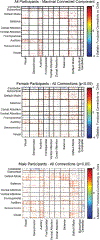Individual differences in aesthetic engagement are reflected in resting-state fMRI connectivity: Implications for stress resilience
- PMID: 29908310
- PMCID: PMC6410354
- DOI: 10.1016/j.neuroimage.2018.06.042
Individual differences in aesthetic engagement are reflected in resting-state fMRI connectivity: Implications for stress resilience
Abstract
Objective: Individual differences in aesthetic engagement-the propensity to be moved by art, nature, and beauty-are associated with positive health outcomes, as well as stress resilience. The purpose of the current study was to identify potential neural substrate mechanisms underlying individual differences in aesthetic engagement and reported proneness to aesthetic chill.
Methods: Data from the Human Connectome Project (HCP) 1200 Subjects Release were utilized. Resting-state fMRI connectivity was extracted for 361 regions in the brain including cortical, subcortical and cerebellar regions for each participant, using participant-specific segmentation and parcellation of subcortical gray matter nuclei and a network-based statistics analytical approach. The Aesthetic Interests subcluster of the Openness to Experience scale (NEO-Five Factor Inventory; NEO-FFI) was used to characterize individual differences in aesthetic engagement and chill.
Results: Participants reporting higher aesthetic engagement, particularly proneness to aesthetic chill responses, exhibited significantly higher connectivity between the default network and sensory and motor cortices, higher connectivity between the ventral default and salience networks, and decreased connectivity between the cerebellum and somatomotor cortex.
Conclusions: Current findings suggest that greater integration of the default mode network, involving processing of internal narrative, with neural representations of sensory perception and salience detection may be a mechanism underlying individual differences in aesthetic engagement. Thus, these individual differences may reflect general integration of environmental perception with internal emotional experience, which in turn may facilitate comfort with novelty, self-regulation, and positive adaptation to potentially stressful experiences.
Keywords: Aesthetics; Openness to experience; Resting state functional connectivity; Stress resilience; fMRI.
Copyright © 2018 Elsevier Inc. All rights reserved.
Figures




References
-
- Adelstein JS, Shehzad Z, Mennes M, DeYoung CG, Zuo XN, Kelly C, … Milham MP (2011). Personality is reflected in the brain’s intrinsic functional architecture. PLoS ONE, 6. doi:1371/journal.pone.0027633 - PMC - PubMed
-
- Belsky J, Bakermans-Kranenburg MJ, & van IJzendoorn MH (2007). For better and for worse: Differential susceptibility to environmental influences. Current Directions in Psychological Science, 16, 300–304.
Publication types
MeSH terms
Grants and funding
LinkOut - more resources
Full Text Sources
Other Literature Sources
Miscellaneous

